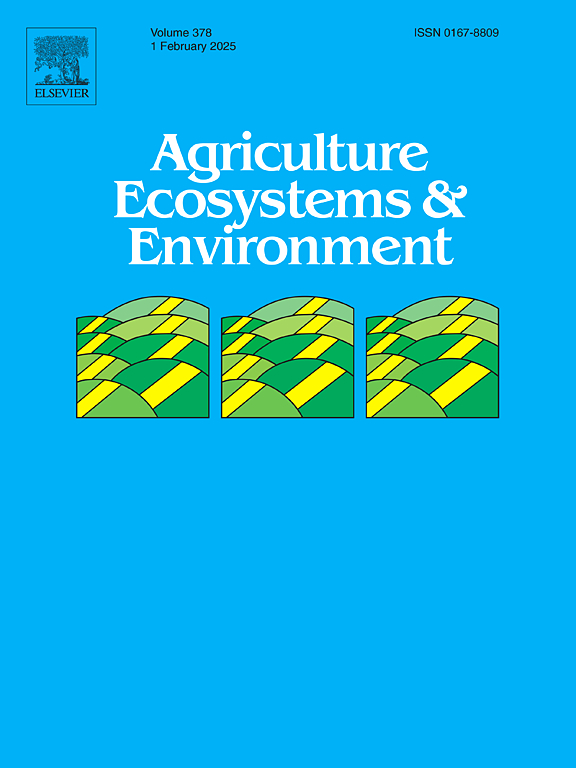Soil organic matter fractions in the topsoil and subsoil of woody crop systems: Impact of reduced tillage plus cover crops under rainfed semi-arid Mediterranean conditions
IF 6
1区 农林科学
Q1 AGRICULTURE, MULTIDISCIPLINARY
引用次数: 0
Abstract
Carbon dynamics in deep layers have potential for soil C sequestration and contribute to the fight against global climate change, however, in Mediterranean regions, most studies focus on the top 20–30 cm soil layer. To advance this knowledge, this study proposes to investigate the behavior of different SOC compartments in the topsoil (0–15 cm) and subsoil (15–60 cm) in two rainfed almond orchards under conditions typical of Mediterranean regions. The treatments evaluated included seeded cover crops (SCC), and spontaneous cover crops (NCC) combined with reduced tillage and traditional tillage (TT). Moreover, an undisturbed natural reference area (forest) representing the pre-cultivated conditions was included. Samples from two experimental sites (Burete and Cagitán) were collected at intervals of 0–15, 15–30, 30–50 and 50–60 cm, and quantified bulk density, soil organic carbon (SOC), particulate organic carbon (POC) and Nitrogen (PON), hot water extractable carbon (HWOC) and short-term mineralizable carbon (SMC). The results showed that the use of cover crops and reduced tillage improve microbial activity, increase soil organic matter fractions, and improve carbon storage, both in the topsoil and subsoil, being an effective and useful strategy for the improvement of soil C sequestration under rainfed almond crop systems in semi-arid areas. In addition, the positive effect of cover crops on SOC storage would have been underestimated by about 35–40 % without accounting for the stock at the 30–60 cm layer. The use of different organic carbon and nitrogen fractions has furthered the understanding of soil carbon dynamics and proved effective in detecting differences among soil management strategies.
木本作物系统表层土和底土中的土壤有机质组分:在雨养半干旱地中海条件下减少耕作加覆盖作物的影响
深层的碳动态具有固碳潜力,有助于对抗全球气候变化,然而,在地中海地区,大多数研究集中在20-30 cm土层的顶部。为了进一步了解这一知识,本研究提出在地中海地区典型条件下,研究两个雨养杏仁果园表土(0-15 cm)和底土(15-60 cm)中不同有机碳区室的行为。评估的处理包括种子覆盖作物(SCC)和自然覆盖作物(NCC)结合减少耕作和传统耕作(TT)。此外,还包括一个未受干扰的自然参考区(森林),代表预开垦条件。在两个试验点(Burete和Cagitán)分别以0-15、15-30、30-50和50-60 cm的间隔采集样品,量化容重、土壤有机碳(SOC)、颗粒有机碳(POC)和氮(PON)、热水可提取碳(HWOC)和短期矿化碳(SMC)。结果表明:在半干旱区旱作杏仁系统中,覆盖作物和减少耕作可提高表层和底土微生物活性,增加土壤有机质组分,提高碳储量,是改善土壤碳固存的有效策略。此外,如果不考虑30-60 cm层的蓄积量,覆盖作物对有机碳储量的积极影响将被低估约35-40 %。不同有机碳和氮组分的使用促进了对土壤碳动态的理解,并被证明是检测土壤管理策略差异的有效方法。
本文章由计算机程序翻译,如有差异,请以英文原文为准。
求助全文
约1分钟内获得全文
求助全文
来源期刊

Agriculture, Ecosystems & Environment
环境科学-环境科学
CiteScore
11.70
自引率
9.10%
发文量
392
审稿时长
26 days
期刊介绍:
Agriculture, Ecosystems and Environment publishes scientific articles dealing with the interface between agroecosystems and the natural environment, specifically how agriculture influences the environment and how changes in that environment impact agroecosystems. Preference is given to papers from experimental and observational research at the field, system or landscape level, from studies that enhance our understanding of processes using data-based biophysical modelling, and papers that bridge scientific disciplines and integrate knowledge. All papers should be placed in an international or wide comparative context.
 求助内容:
求助内容: 应助结果提醒方式:
应助结果提醒方式:


